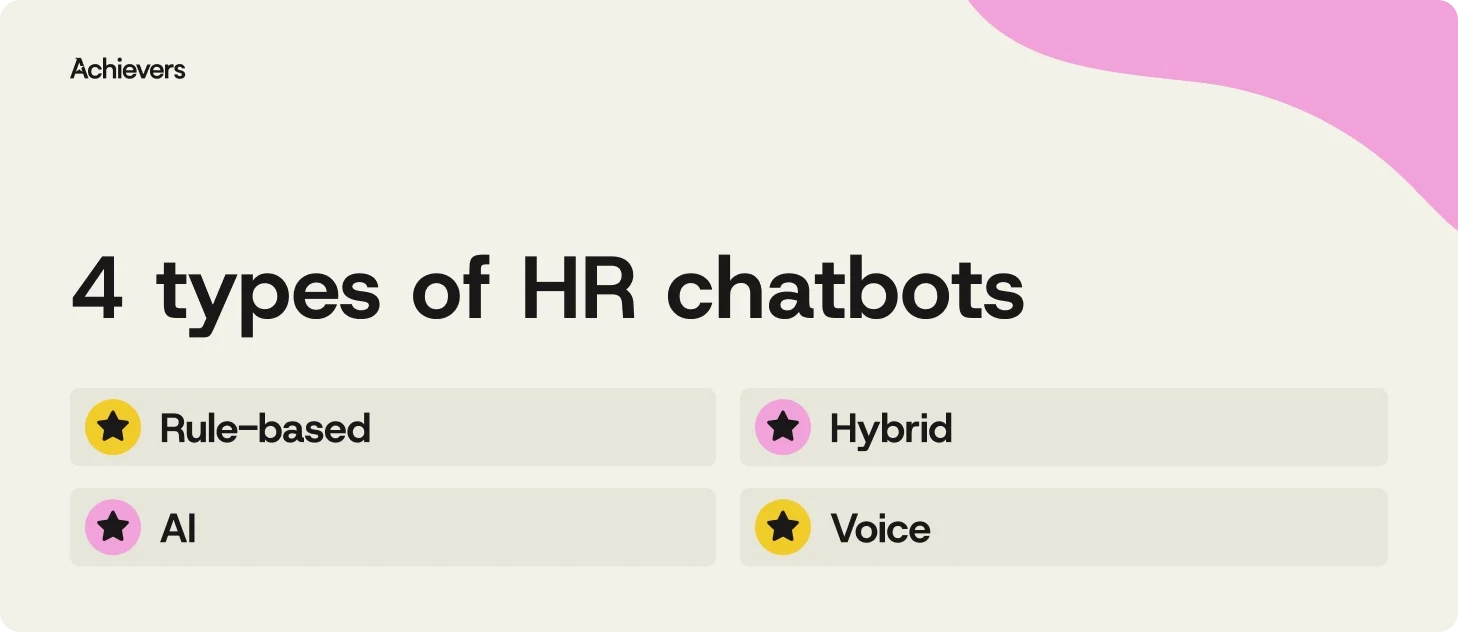Table of contents
Create a culture that means business™
Schedule a demo with an Achievers solution expert today.
HR chatbots are here to stay — and for good reason. From boosting employee engagement to streamlining HR processes, these AI-driven tools are transforming the workplace. As work gets more digital, especially in hybrid setups, building strong connections can be a real challenge. New hires can get lost in the shuffle, and teams might struggle to stay in sync.
Enter HR chatbots. These tools leverage AI to enhance efficiency, boost engagement, and offer timely support, making them essential for any organization trying to keep up — or, better yet, stay ahead.
Let’s dive into how HR chatbots can help tackle these challenges and elevate the employee experience across your company.
What are HR chatbots?
HR chatbots are like your HR department’s digital sidekick — powered by AI to make processes faster and more efficient. In fact, 62% of employees prefer using chatbots for HR-related tasks, proving just how effective they are. These smart tools use natural language processing to chat with employees or potential hires, helping them effortlessly navigate the workplace.
What are the four types of HR chatbots?
There are four main types of chatbots organizations can tap into, each with its own unique strengths:

1. Rules-based chatbots
Think of these as the reliable workhorses of the chatbot world. They follow a set of predetermined rules and workflows, making them perfect for tackling basic tasks like answering FAQs or processing simple inquiries. They’re fast, efficient, and stick to the script — but don’t expect them to improvise when things get complex. Unlike more advanced HR chatbots, they’re not built for learning on the go.
2. AI chatbots
AI chatbots are where the magic happens. Powered by machine learning and natural language processing (NLP), they engage in more fluid, meaningful conversations. They go beyond basic answers by personalizing interactions based on user data, preferences, and past conversations. The more they interact, the smarter they become, leading to better engagement and a constantly improving experience.
3. Hybrid chatbots
Hybrid chatbots balance reliability with intelligence. They handle routine tasks with the dependability of rules-based systems while using AI to manage more complex conversations. This makes them a versatile solution, able to quickly address simple inquiries and seamlessly shift to more dynamic scenarios when needed — striking the perfect balance for many businesses.
4. Voice bots
Voice bots take interaction to the next level by engaging through spoken language. Using speech recognition technology, these HR chatbots allow employees to communicate naturally, making the process feel more human. Voice bots are especially user-friendly and ideal for those who prefer a hands-free experience.
The benefits of HR chatbots
HR chatbots are designed to streamline HR operations, from answering questions to offering real-time insights, all while freeing up HR professionals to focus on what matters most — like talent development and strategy. Here’s how AI chatbots can make a difference in today’s workplaces:
- Increased efficiency: By automating tasks like answering FAQs and managing inquiries, AI chatbots allow HR teams to focus on high-impact activities, driving productivity.
- Enhanced communication: Available 24/7, AI chatbots make sure employees always have access to the most current HR information, cutting confusion and keeping everyone on the same page.
- Improved onboarding: Chatbots guide new hires through policies and paperwork, helping them feel more at ease and get productive faster.
- Personalized insights: Using data, AI chatbots tailor responses based on the employee’s role, location, and history, creating a more personalized experience.
- Boosted engagement: Whether in the office, remote, or hybrid, AI chatbots make HR support accessible, keeping employees engaged and HR operations running smoothly.
How to improve employee experience with HR chatbots
HR chatbots are here to make the employee experience smoother and more connected. And when used the right way, they can really make a difference. Here’s how:
1. Collect and understand employee feedback
Let’s face it — no one enjoys the long, drawn-out process of annual surveys. HR chatbots make feedback quick, easy, and real-time. Whether it’s a simple emoji or a brief comment, employees can share how they’re feeling in the moment. This instant feedback gives managers a clear picture of team dynamics, allowing them to act quickly and keep things on track.
2. Stay connected with remote employees
Remote work can feel isolating, and staying connected is key. HR chatbots help bridge that gap by providing 24/7 support, allowing remote employees to check in and feel heard at any time. By integrating the chatbot with tools like Slack or Teams, you make HR support easily accessible, so remote employees never feel left out.
3. Overcoming HR chatbot challenges
Introducing a chatbot can raise concerns, especially about confidentiality. But with the right encryption and permissions, sensitive information stays safe. It’s also natural to worry that chatbots might just route questions to HR, creating more work. But AI-powered chatbots are designed to learn over time, becoming smarter and more helpful — reducing the need for human intervention and giving HR teams valuable insights.
4. Open a 24/7 feedback channel with an HR chatbot
HR chatbots provide a constant feedback loop, making it easier for employees to share their thoughts and for managers to understand what’s working — and what’s not. With Achievers’ Voice of Employee tool, paired with our AI-powered chatbot, employees get personalized support anytime. Plus, our chatbot guarantees real-time responses and will connect employees to live agents, ensuring they get the personalized service they deserve.
Top 5 features to look for in HR chatbots
When choosing a chatbot, it’s important to focus on the features that will make a real difference. Here are the top five to prioritize:
- AI-powered personalization: Your chatbot should get smarter with every interaction. Look for AI that tailors responses based on an employee’s role, preferences, and history. Personalization drives engagement and makes employees feel heard.
- Seamless integration: A chatbot that plays well with your existing tools (HRMS, CRM, Slack, etc.) ensures everything flows smoothly. Integration means less hassle and more efficiency for both HR and employees.
- Real-time feedback: The beauty of chatbots is their ability to collect real-time feedback, making it easy for employees to share their thoughts as they happen. This gives teams the insights they need to make fast, informed decisions.
- 24/7 availability: HR support shouldn’t clock out. A chatbot that’s available 24/7 ensures employees can always access the help or feedback they need, no matter when or where they’re working.
- Secure data handling: Your chatbot should be secure — period. Make sure it’s equipped with encryption and permissions to keep sensitive data safe, giving employees the confidence to engage without worry.
Turn employee insights into action with HR chatbots
HR chatbots work best when they’re part of a bigger picture — one that turns feedback into action and drives continuous improvement. When employees feel heard and feedback flows freely, your workplace gets better, faster.
With innovative employee feedback tools from platforms like Achievers, gathering insights becomes seamless, not another task. You’ll have the data and guidance you need to act — helping you nurture a workforce that’s engaged, connected, and ready to thrive.



